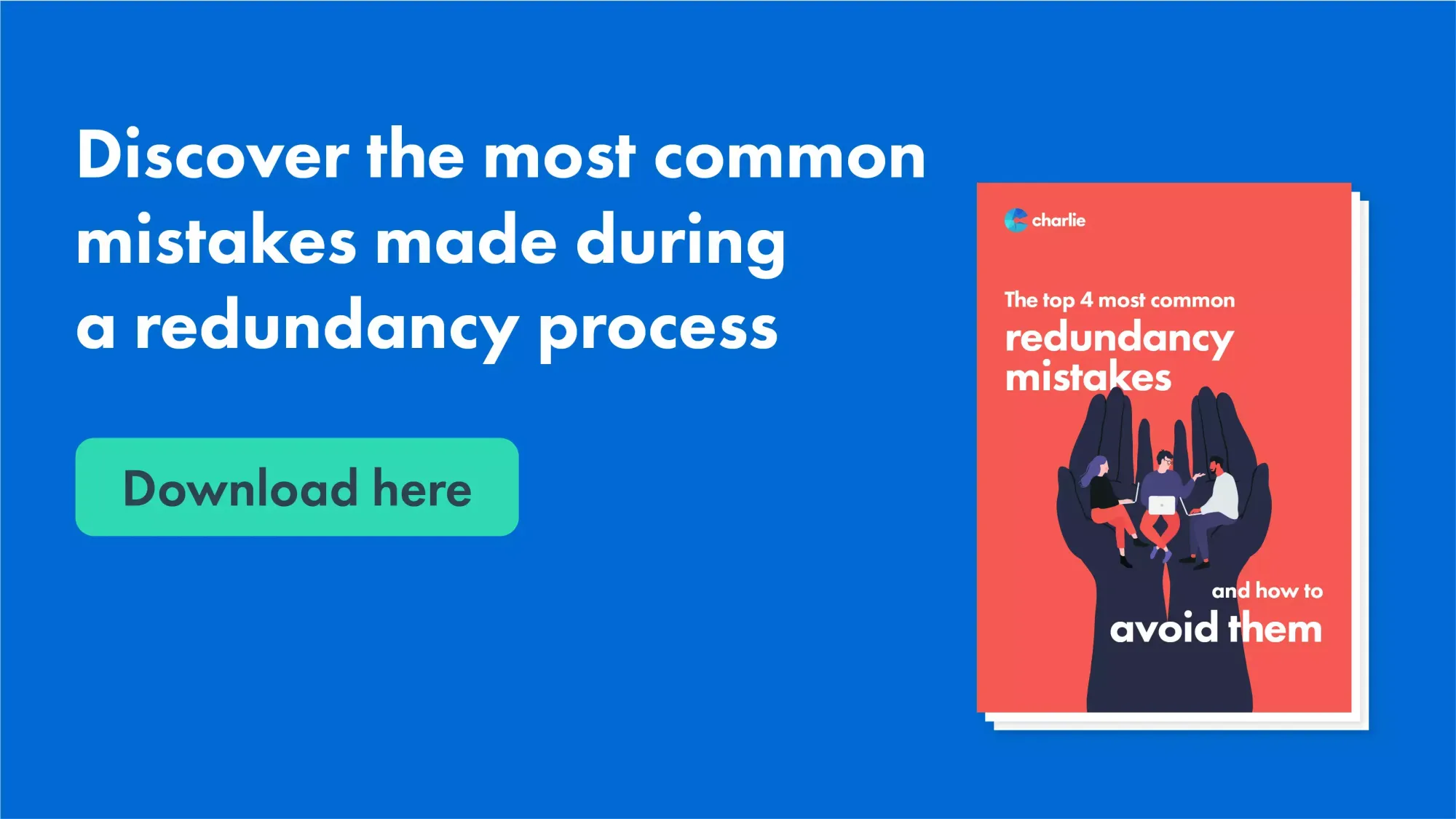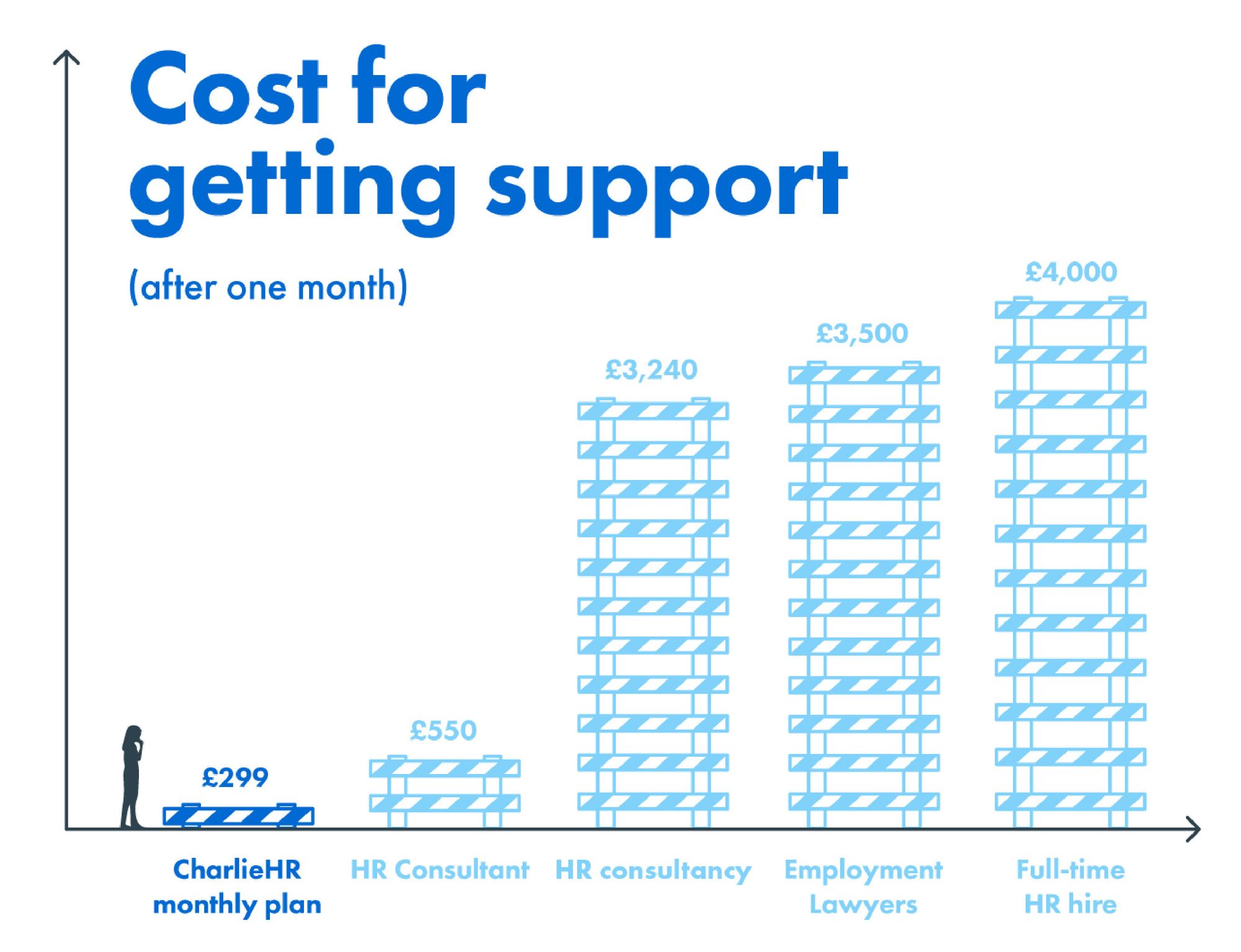Making someone redundant: a guide for small businesses

Making someone redundant is one of the hardest things you'll ever have to do – and you need to get it absolutely right, for the sake of your team and of your small business. In this post, I’ll use my experience as an HR advisor to show you how to run a redundancy process that's both in line with the law and fair on your team.
What is redundancy?
Redundancy is the process by which an employer ‘lets someone go’ from their company when there’s no longer a business need for the work they are doing.
It’s a very different thing to ‘firing’ someone (find out more about written warning templates) or letting someone go during their probation period, which implies that the employee has done something wrong – when someone is made redundant, it’s simply because their role no longer exists.
What are examples of redundancies?
In my experience, it can be confusing to understand when redundancies can happen, but as a small business owner, you need to be sure about the information.
Below, I'll give you reasons why you can make your team members redundant along with concrete examples:
- The employee’s position is no longer needed due to a change in the business – for example, you may be reducing the number of customer service agents due to a significant drop in incoming queries after implementing a chatbot on the website
- The tasks the team member was assigned are taken on by coworkers – you're combining marketing activities and therefore no longer needing someone to deal solely with social media management
- The business has gone insolvent – redundancies are made as the business ceases operations, and employees get their redundancy payment through the sales of assets
- The business is relocating – you're deciding to focus sales revenue in the Liverpool area instead of the Portsmouth area, meaning the business no longer needs sales representatives in Portsmouth. They can choose to relocate or you will have to make them redundant and hire new staff.
Even if these are concrete examples of when redundancies can happen, keep in mind that redundancies always depend on your company context.
There are many layers of complexity when it comes to making redundancies, which is why getting legal expertise on the matter is essential, but to give you a head start, let’s have a look at the step-by-step guide I put together. And if you don't have time, download it below.

A step-by-step guide to making someone redundant
After you've made sure you want to and can make compulsory redundancies, you need to go through a step-by-step process set by Acas.
Not only does following this process ensure you’ll keep on the right side of the law (although that’s an important aspect). It’s also about handling the redundancy process in a way that’s fair, considerate and respectful of the person you’re letting go from the company.
I’ll guide you through the whole redundancy process set out by Acas, but I’ll focus primarily on how that applies to small businesses and startups.
Regardless of your situation, there's no getting away from the fact that this is a complicated process that needs to be handled carefully – get it wrong, and your company could face a time-consuming and expensive tribunal case that would make it difficult to keep your small business afloat.
Step 1 – Running a redundancy consultation
The way your company makes decisions about who is made redundant needs to be as transparent as possible. That is achieved via a redundancy consultation.
Redundancy consultations aren’t an optional step in the process. If you make any redundancies without going through a consultation process, those redundancies are almost certainly going to be unfair – and you not only risk being taken to an employment tribunal but lose all trust from the team members staying at your business.
This process starts with notifying your employees that you are entering into a redundancy consultation. That means informing them of:
- The business reasons for the redundancies
- The number of redundancies you are expecting
- What parts of the business will be affected
- How you plan to select employees for redundancy
- How you’ll carry out redundancies
- How you’ll work out redundancy payments
The details of how you should run a redundancy consultation process depend on two main factors:
- The number of people you’re making redundant: if you’re planning to make more than 20 people redundant, you need to do a collective consultation with a person representing that group. You’ll also need to contact the Redundancy Payments Service before your consultation begins.
- Their personal circumstances: being made redundant will mean different things for each of your team members. Will they work during their notice period? Or will they leave the company immediately? Would they consider being moved to another role to avoid being made redundant?
You’ll have to consider these factors before starting your consultation process — they’ll ultimately change the format of the consultation and what you’ll have to tell your team.
If you’re not sure how to go about preparing for these conversations on a case-by-case basis, my HR team and I can help. Through HR support for small businesses offered by CharlieHR, we can ensure every team member is treated fairly and compassionately, whilst keeping your HR compliant.
Step 2 – Sending an 'At risk of redundancy' letter
You will also need to notify the employees who could be affected by redundancy one-by-one by sending them an ‘at risk of redundancy letter’.
In this letter, you must include details such as:
- why you are considering making redundancies
- how long the consultation process will take
Step 3 – Making a decision on who to make redundant in your team
If you have more than one employee in the job role that is being made redundant, you’ll need to identify who you’re going to let go. Your process for making this decision has to be a fair one – you can’t discriminate according to who you’d personally prefer to see stay or go.
This is especially significant for small businesses and startups – letting go of people needs to be weighed very carefully, as each team member usually holds a lot of responsibility
A fair selection criteria for redundancy would include things like:
- An employee’s skills or qualifications
- Their aptitude for their role
- Their historical standard of performance
- Their attendance or disciplinary record
- Their length of tenure at the business
On the other hand, some selection criteria are automatically unfair. You mustn’t choose an employee for redundancy based on any of the following reasons:
- They are pregnant
- They make use of statutory or contractual parental leave
- They have been acting as a trade union representative, or have joined a trade union
- Their age, disability, gender, or marriage and civil partnership status
- Their religion, belief, or sexual orientation
Do so, and you’ll be guaranteed to get a court case on your hands. If you want to make sure you have some backup, we also strongly advise you to get an employer's liability insurancebackup – more info in our guide.
Step 4 – What to say when making someone redundant
Once you’ve completed the redundancy consultation, you need to notify the employees of your decision and your reasons for it. The best – and fairest – way of doing that is by a face-to-face meeting (or a video call if your business operates remotely and you have no way to meet in person).
When you have the meeting to notify someone of their redundancy, don’t drag out the conversation. Tell them in the first sentence what you have decided, and then go into the business reasons for your decision.
I want to be honest with you. The role that you currently do no is no longer going to exist so we have to make it redundant.
When you do go into your reasoning, keep the conversation within the frame of business logic – remember, this isn’t about them or their performance, it’s just that their job no longer exists.
Outline the support that your business is able to provide to help them find a new role. Career advice from senior members of your company, intros to other businesses where there might be a suitable role, time off from work to make applications – all these things will help make sure the employee lands gently.
At Charlie, we know how difficult these conversations can be for both employers and team members. This is particularly true for startups’ close-knit teams where everyone knows each other well and is highly invested in the business. That’s why it’s important to make sure you have all the tools in hand to tackle it.
Step 5 – Redundancy notice letter
You must follow up on this meeting with a redundancy notice letter, setting out your decision and reasoning in writing.
You should prepare your redundancy letter very carefully and ensure it includes all the information required by the law.
Before writing the letter, you should make sure you know the answers to these five questions:
1. How much notice should team members get?
You need to notify team members of your decision with enough notice.
The amount of notice you are obliged to give depends on how long they have been working for you.
- 1 month to 2 years = at least a week
- 2 years to 12 years = a week’s notice for every year they’ve worked for you
- 12 years or more = 12 weeks
2. How does redundancy pay work?
When we talk about redundancy pay, we’re really talking about two things.
- Notice pay (or payment in lieu of notice)
- Statutory redundancy pay
3. What is notice pay?
Notice pay is simply the employee’s standard pay or salary, which you are obliged to continue paying for the duration of their notice. However, you can also let this person leave the business before their notice is up by paying it in advance (payment in lieu of notice).
4. What is statutory redundancy pay?
UK law sets out a certain minimum level of statutory redundancy pay which employers are obliged to abide by. To be eligible for statutory redundancy pay, an employee needs to have been employed with you for two years.
5. How to calculate redundancy pay?
Statutory redundancy pay is calculated through a combination of the employee’s age and the length of their tenure. Here’s how it works:
Employees are entitled to:
- 1.5 weeks’ pay for each full year of employment after their 41st birthday
- A week’s pay for each full year of employment after their 22nd birthday
- Half a week’s pay for each full year of employment up to their 22nd birthday
The upper limit on the amount of statutory redundancy pay is £15,750.
Once you’ve collected all this information about each of the team members you are making redundant, you need to collate it into clear redundancy notice letters (one per team member) and send these in a timely manner.
If you are making more than one person redundant, you need to think about these common mistakes:
- Making miscalculations
- Forgetting about any details that are required by the law
- Sending the letter at the wrong moment in the redundancy process
- Getting the tone wrong — either too colloquial and amateurish or filled with obscure legal jargon
Perhaps that’s where we can offer our help. With HR advice from Charlie, you get a dedicated advisor to check all your redundancy letter details for you. We will:
- Go through each of the people you are making redundant and make sure you calculated their notice period, notice pay and statutory pay correctly
- Help you write a professional letter with a style that also reflects your company identity and guarantees compliance (find out more in our HR compliance checklist)
- Advise you on the right time to send out the letter
- Always be there to answer any questions you may have throughout the process
Extra: top 4 redundancy mistakes (and how to avoid them)
In the redundancy process, there are a number of challenges that can’t be solved through a Google search.
Working at Charlie and speaking to small businesses on a daily basis, I’ve learned that these mistakes are very common at this stage of your journey. That’s why my job is to ensure you’re covered on all fronts.
As an extra step, I compiled the four mistakes you should always be on the lookout for when it comes to redundancies.
1. Making someone redundant instead of firing them
It’s worth making one thing clear, straight off the bat – for a redundancy to be genuine, you’ll need to be able to demonstrate that the employee’s job no longer exists or is no longer needed.
There is an important difference between these two concepts:
- Termination (when you fire someone for performance or gross misconduct reasons. Usually someone else is hired into their position to complete the tasks they were doing)
- Redundancy (when a role is no longer needed at a company).
Confusing the two by, for example, making someone redundant for misconduct reasons, can lead to serious legal issues, so you need to tread carefully in these areas.
You can only make team members redundant in a limited number of circumstances, which depend on:
- The reasons behind your decision
- Whether the role you’re making redundant fulfils (or not) your business needs
- Your plans for hiring or moving people across the business
2. Making redundancies instead of trying to avoid them
Before you get as far as making someone redundant, there are all sorts of measures you need to consider to see if they can be avoided. If saving money is the objective, then there are all kinds of ways of cutting costs that don’t extend to letting people go. Cheaper office space, withdrawing perks and benefits or Learning and Development budgets are all valid options.
There are also methods of cutting staffing costs that don't go as far as making full-on redundancies. That could mean:
- Reducing your use of freelancers or casual labour
- Slowing down recruitment in other areas of the business
- Reducing or eliminating overtime
- Moving the employees whose jobs no longer exist into other areas of the business
- Short-time working (when an employee works reduced hours)
- Offer some employees early retirement (with incentives to encourage them to take the offer)
3. Forgetting about non-compulsory redundancy (or voluntary redundancy)
Non-compulsory redundancy is where you ask your employees if they’d like to volunteer for redundancy.
For some people, at certain stages of their life, voluntary redundancy might be an attractive option. They could be contemplating a career change, for example. In any case, giving people who are open to redundancy the chance to take it helps you protect the team members who are depending on these jobs more.
So perhaps think about including it as an option – bear in mind, however, that this usually applies to large waves of redundancies and that there usually is an incentive (such as a large package) to choose to be made redundant.
4. Hiring new employees straight after redundancy
There are no hard and fast rules around how long you should wait after making redundancies before you hire someone else. It’s a slightly murky area, and for that reason, it’s worth thinking carefully before you hire anyone again.
The needs of startups and small businesses are ever-changing, so while there’s no specific law that prohibits you from rehiring after a redundancy, you could get in trouble if you are misusing the redundancy process to get rid of someone and hire someone else.
The redundancy process is designed to allow businesses to let people go when there is no longer a business requirement for the role – if the redundancy happens for any other reason, it is not a genuine redundancy and the employee could take you to court for wrongful dismissal.
Many employers get caught out by making redundancies and then re-advertising for the same (or very similar) roles soon after. Unless those companies can provide a good explanation – such as winning a new contract, or similar – employment tribunals might well rule those redundancies as non-genuine and find that those employees were wrongfully dismissed.
That’s why you should carefully look at new roles you want to hire for on a case-by-case basis, and flag if any of them may breach the redundancy regulations. Perhaps bring someone in from the outside for advice.
Of course, the cost of bringing external expertise cannot always be footed by small businesses and startups.
At Charlie, we’ve come up with a system that allows you to get HR advice on demand. That could really be the help you need when it comes to handling difficult situations such as redundancies, but not only.
You could also get experts to review your employment contracts templates, help you craft HR policies, create a company handbook and much more.
Below, I put together a comparison of the packages you could get so you have an idea of what the market looks like.

And if you’d like to hear more about how to handle redundancies, we’ve also released a webinar with our CEO, Ben Branson-Gateley, you can have a look here to under how to run a redundancy process that’s legal and compassionate whilst protecting the future of your company.
As challenging as redundancies are, we hope this step-by-step guide will help you conduct a thorough, fair and compliant redundancy process.




